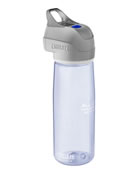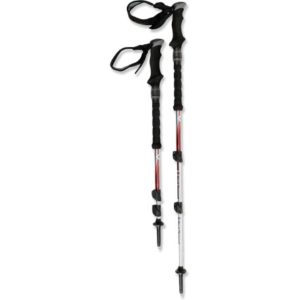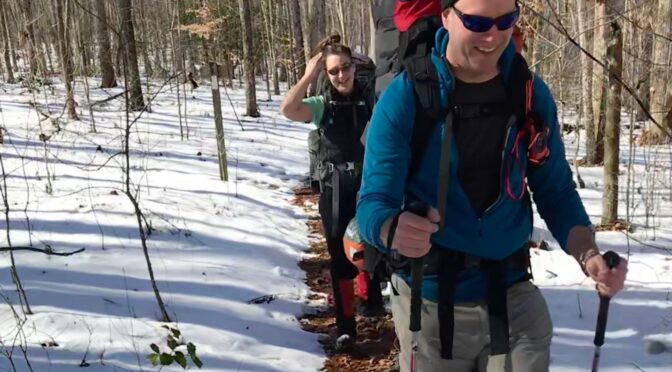We’ve reached late fall, the transition between glorious fall hiking and winter, a period many see as a three-month hiatus from the trail. Why? Well, we know not why: for us, it has become our favorite season to be on the trail. It’s a topic we’ve waxed on at length; here, for instance.
Today, we address the practical, offering eight tips to help you deal with winter’s unique challenges. Who knows, they might just change your thoughts about hanging up the hiking boots ’til March.
Know your pace. Do you know how fast you hike? Do you have any idea? Knowing how fast you hike can be valuable information in any number of situations. For example, it’s late afternoon, you want to take a 5-mile hike. The sun sets in 2 hours and you’re not a fan of hiking in the dark. Do you have time for the hike? If you don’t know your pace, it’s pretty easy to figure out. Go to a trail with a known distance. Set your watch, hike. When you get back, take the time it took you to hike (using total minutes is probably easiest) and divide it by the mileage. So if it took you an hour (60 minutes) to hike three miles, divide 60 by 3 and there’s your pace: 20 minutes per mile (not a bad pace, fyi). Keep in mind that your pace will vary based on various factors, including the type of terrain you’re hiking (mountains will be slower) and how much weight you’re packing. Knowing your pace can keep you from getting caught by surprise in the dark, especially important when the temperature can drop a good 10 degrees within minutes of sunset.
Speaking of sunset … . Knowing when the sun sets is especially important on a winter hike (for reasons noted above). Before heading out, check sunset (and sunrise) times at sunrise-sunset.org.
Dress appropriately. A lot of folks hang up their hiking boots come winter because they simply don’t know how to dress. When it comes to exercising in winter your comfort comes down to two things: 1) avoid cotton clothes: cotton gets wet, it stays wet, you get cold, and; 2) wear layers. Wear a lightweight wool or synthetic layer next to your skin, cover it with a slightly heavier wool/synthetic layer. If it gets colder, you may need to add a third layer, a shell, perhaps. Wool hats and gloves help you regulate your body temperature: Too hot? Off they go. Too cold? Put ‘em back on. Wear a thicker sock in winter. The basics of layering are just that that. To get a better grip on the subject, check out this piece we wrote for our friends at Great Outdoor Provision Co.
Snacks. Your body burns more calories in winter in an effort to keep the body warm — this is true even if you’re an expert at layering. High calorie snacks — a few mini-Snickers tucked into your hip-belt pocket, say — will keep you moving and keep you warm. Give yourself permission to eat on the trail, even if it’s a relatively short hike.

Hydration. Even though you aren’t sweating as much in cold weather, you’re still sweating and you need to replace that sweat. According to an article in Runner’s World by William O. Roberts, MD, “Fluid replacement is easily accomplished in the cold by drinking to thirst … then resuming your usual post-activity fluid intake.” So, when you get thirsty, drink.
Know your route. You should always take a map when you hike, but you should also go over the map beforehand and get a feel for a few things, including: 1) Topography. If the topo lines are close together and the trail is squiggly, be advised that this 6-mile hike may take you longer than it does to hike 6 miles on the local greenway; 2) Look for stream crossings (the wiggly blue lines) that cross your trail. Maybe they have bridges, maybe they don’t. If you’re hiking in the shadow of a big rainstorm, keep in mind that those streams might be difficult to cross, that you might want to bring an extra pair of socks and use trekking poles, at the least; 3) Bailout routes and nearby roads. A few years ago we had a hiker who needed evacuating from one of the worst spots imaginable, Linville Gorge. Fortunately, we were near one of the few spots that I knew was close to a road, and we were able to get her out with little trouble.

Use trekking poles. I’m an advocate of trekking poles year round, but especially in winter. They make those dicey stream crossings easier by helping your balance, they help you better navigate icy patches, and because they engage your core and arms, they help keep your upper body toasty, too.
Don’t hike alone. Yes, I confess: I hike alone year-round. But in winter, when I go solo I try to hike trails that see some traffic. You sprain an ankle — or worse — and can’t move, you could be in for a long, cold, dangerous night if no one happens along. For this reason, too, be sure to tell someone where you’ll be hiking and when you expect to be back.
Embrace the winter hike. Prepare for it and you’ll be amply rewarded.
